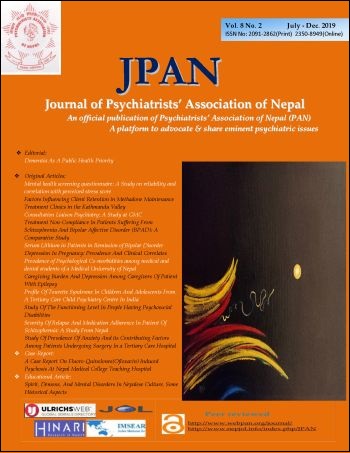Serum Lithium in Patients in Remission of Bipolar Disorder
DOI:
https://doi.org/10.3126/jpan.v8i2.28021Keywords:
BPAD, Serum Lithium Level, RemissionAbstract
Introduction: Bipolar affective disorder a chronic, and highly disabling psychiatric disorder is one of the leading causes of disability and is estimated to affect more than 1% of the global population irrespective of origin, ethnicity, nationality or socioeconomic status. The effectiveness of lithium in mania and psychotic excitement was proven first proven in 1960 and since then lithium is considered to be a gold standard treatment for bipolar disorder.
Material and Method: A total of one hundred thirty five patients with bipolar disorder were enrolled in a prospective study to analyze the serum lithium levels on maintenance dose of lithium. After ethical clearance data was collected from patients attending BG Hospital and Research Centre from July 2013 to July 2019. The patients who were on maintenance treatment with different doses of lithium only were included. These patients were tested for serum lithium concentration as per lithium monitoring guidelines. Serum Lithium, serum electrolytes, height and weight of the patients were recorded. The psychiatric diagnosis was made according to the ICD-10 criteria. Data were computed and analyzed by using SPSS version 21. Parametric and non-parametric statistical technique was applied wherever appropriate.
Results: The minimum efficacious serum lithium level in the long-term treatment of bipolar disorder was found at 0.16 mmol/l and maximum serum levels was 1.51 mmol/l. The mean serum lithium level was 0.596 mmol/l with standard deviation of 0.237 mmol/l.
Conclusion: There is substantial variation in between the serum lithium levels of patients in remission on long term treatment. The uncertainty about the most efficacious serum lithium level for the long-term treatment of bipolar disorder leads to the suggestion of the treatment of individual patients to be based on clinical response rather than on serum lithium levels.
Downloads
Downloads
Published
How to Cite
Issue
Section
License
This license enables reusers to distribute, remix, adapt, and build upon the material in any medium or format, so long as attribution is given to the creator. The license allows for commercial use.




